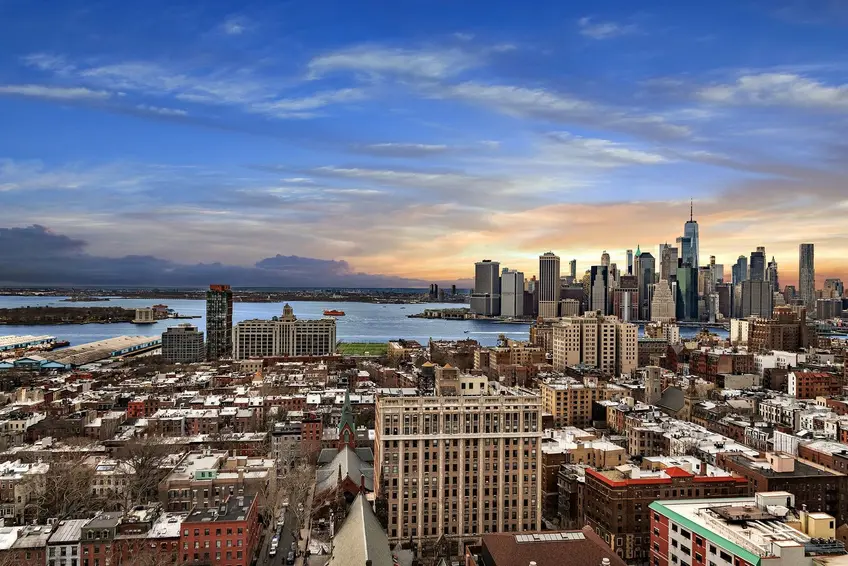 View from 75 Livingston Street, Unit 23AB (via Compass https://www.cityrealty.com/nyc/brooklyn-heights/75-livingston-street/apartment-23AB/ArqQTaVtjcAD)
View from 75 Livingston Street, Unit 23AB (via Compass https://www.cityrealty.com/nyc/brooklyn-heights/75-livingston-street/apartment-23AB/ArqQTaVtjcAD)
After several years of historically low mortgage rates, a March 2022 decision by the Federal Reserve to increase the prime rate has resulted in an unexpected and significant mortgage rate hike. A year ago, many buyers were locking in to 30-year loans at rates hovering around 3 percent and sometimes much lower. Since January 2022, rates have crept back up to 5 percent on average, and there are indications that rates may go much higher by the end of 2022. This article explores how rising interest rates will impact buyers and sellers and further explores why history may not repeat itself as interest rates rise.
What Higher Rates Mean for Buyers
While the current interest hike won’t price out all potential buyers, it seems likely to price out some buyers, especially first-time buyers eyeing entry-level properties. Expensive markets, including those found in cities like New York and San Francisco, also seem bound to be hit hardest for an obvious reason. Buyers in these locations typically require higher levels of financing due to the high cost of housing. As a result, they naturally pay a higher penalty when interest rates soar. But this isn't the only way buyers may be impacted by rising interest rates in 2022 and beyond.
In the past, high interest rates have usually resulted in fewer transactions as unfavorable lending rates deter potential buyers. As properties linger on the market longer, inventory grows, and this eventually drives prices down. In 2022, there is no guarantee this familiar scenario will play out because there is nothing typical about the current market.
In the past, high interest rates have usually resulted in fewer transactions as unfavorable lending rates deter potential buyers. As properties linger on the market longer, inventory grows, and this eventually drives prices down. In 2022, there is no guarantee this familiar scenario will play out because there is nothing typical about the current market.
We’re currently watching interest rates rise in a market defined by historically low inventory and high property values. As a result, even if half of the current buyers are priced out due to rising interest rates, it seems unlikely that inventory will immediately expand because many people will still be looking to buy. Indeed, given the strong demand and low inventory, property prices seem likely to remain high throughout 2022, even as interest rates rise. If this plays out, it will be a unique situation and one that isn’t ideal for buyers, especially those attempting to enter the market for the first time.
What Higher Rates Mean for Sellers
If you bought a property when interest rates were low, or you renegotiated your mortgage and locked into a lower interest rate in 2020 to 2021, you're likely breathing a sigh of relief—that is, unless you're looking to sell and rebuy at this time.
On the selling side, the impact of the recent hike in rates will likely not be significant, at least not immediately. Once again, given the low inventory (not just in New York but nationwide), most properties are likely to still attract buyers willing to pay market or above market rates and are unlikely to linger on the market for a long time. One potential problem is that as interest rates rise, some individuals who pre-qualified before the rate hike may no longer qualify, which could initially lead to more bids falling through due to rejected financing applications.
On the selling side, the impact of the recent hike in rates will likely not be significant, at least not immediately. Once again, given the low inventory (not just in New York but nationwide), most properties are likely to still attract buyers willing to pay market or above market rates and are unlikely to linger on the market for a long time. One potential problem is that as interest rates rise, some individuals who pre-qualified before the rate hike may no longer qualify, which could initially lead to more bids falling through due to rejected financing applications.
The real problem facing sellers won't be finding buyers, but figuring out where to go next. For anyone looking to trade up in New York City's five boroughs, the decision is bound to be difficult since, as they trade up, they will still face high prices but now with the added disadvantage of higher mortgage rates. In the past, buying in a more affordable market would have been an obvious option, but even that option is becoming challenging. As businesses have freed up employees to work from any location, there has been a significant departure from coastal cities like New York and San Francisco to housing markets that have traditionally seen few transactions and always been affordable (e.g., markets in states such as Utah, Kansas, and Arizona). In 2022, even if you're ready and willing to pick up stakes and move anywhere, low inventory, high prices, and bidding wars may be impossible to avoid.
 (Pixabay)
(Pixabay)
Buying and Selling in a Tough Market
With interest rates on the rise, property values holding steady, and inventory still low, one might wonder if it is worth moving at all. As always, if you’re ready to buy or sell and have a compelling reason to do so, it is likely still the right time to go on the market.
That said, given the higher interest rates, it is increasingly important to come into any deal with as much cash as possible. For example, if you finance a $850,000 property with 20% down and lock in to a 30-year mortgage at 5%, you'll end up paying $634,139 in interest over the term of the mortgage. If you can put 30% down instead, you’ll end up paying $554,871.92, netting savings of roughly $80,000 over the term. However, if you consistently top up your monthly mortgage payments (and why not, since you'll be paying less by bringing in more cash up front), you will save even more money over time. In summary, if you're looking to buy, sell and purchase a new home, or invest in a property, start saving and aim to come into any transaction with as much cash as possible.
That said, given the higher interest rates, it is increasingly important to come into any deal with as much cash as possible. For example, if you finance a $850,000 property with 20% down and lock in to a 30-year mortgage at 5%, you'll end up paying $634,139 in interest over the term of the mortgage. If you can put 30% down instead, you’ll end up paying $554,871.92, netting savings of roughly $80,000 over the term. However, if you consistently top up your monthly mortgage payments (and why not, since you'll be paying less by bringing in more cash up front), you will save even more money over time. In summary, if you're looking to buy, sell and purchase a new home, or invest in a property, start saving and aim to come into any transaction with as much cash as possible.

Contributing Writer
Cait Etherington
Cait Etherington has over twenty years of experience working as a journalist and communications consultant. Her articles and reviews have been published in newspapers and magazines across the United States and internationally. An experienced financial writer, Cait is committed to exposing the human side of stories about contemporary business, banking and workplace relations. She also enjoys writing about trends, lifestyles and real estate in New York City where she lives with her family in a cozy apartment on the twentieth floor of a Manhattan high rise.

 6sqft delivers the latest on real estate, architecture, and design, straight from New York City.
6sqft delivers the latest on real estate, architecture, and design, straight from New York City.
